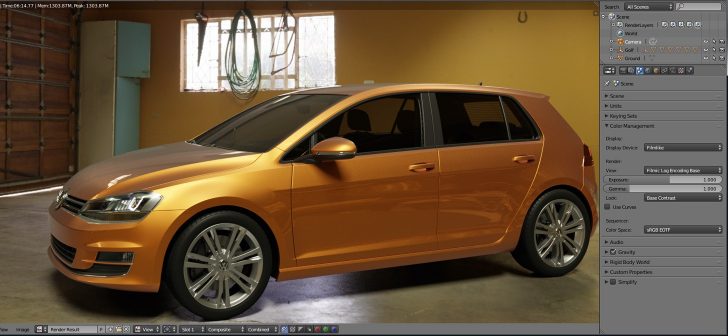Filmic Blender is an OpenColorIO configuration for Blender that will help you improve your renders - but there's a catch. Read on as Manuel Albert tells us about his experiences with the script.If you ever asked for that magic render button in Blender, the one button that just instantly improves your Blender scene, you should definitely check out Troy Sobotka's Filmic Blender Repository on GitHub.
It's an OpenColorIO configuration crafted by Troy Sobotka and meant to eventually replace Blender's current sRGB EOTF configuration with a far more closer-to-photorealistic view transform.
To break it down, that means that the linear render data that Cycles internally creates will be translated into a far better looking image. You'll have better highlights, better dynamic range and the way light and color look will just be amazing and more natural. Even though it may seem subtle, it's a real game changer.
When I first saw some filmic Blender examples on Twitter, I couldn't exactly pinpoint why the renderings looked so much better, much more realistic. So I just had to try it myself. I downloaded the repository, replaced the color management files in Blender (which is easy - just copy and paste) and rendered the scene.
Unfortunately though, it didn't really look like the examples in the renders and it wasn't really improved. But talking to Troy, asking questions and seeing other 'imagers' use it, helped a lot. Being used to render with sRGB view transform and the tricks you have to use to make things look good were actually the problem. With filmic blender you don't really have to cheat like you were used to and you can use way more realistic values when it comes to setting up lights.
Bassam Kurdali summed it up on Twitter: "When I first used it, I had the same experience other people did: I threw the luts on a scene already lit to see 'how better it would get'. The reason is simple - I had tweaked the lights, materials, setup in my scene with all sorts of hacks to make it look good. The trick is to start a new scene, and light it with intensities that mimic better real light - typically much higher than we used. It's so much more forgiving: smooth roll offs + wide range > clipping, pretty bounce/light wrap effects, sweet hilights"
If you haven't checked it out yet, please give it a try and be amazed by the #filmic_blender examples out there. Thank you Troy Sobotka for educating me (us) on this!
This is the original thread on Blender Stackexchange where it all started & it get's frequently updated with examples.






27 Comments
Here is a slightly cut-down version of a post I made in the Indigo Render forums:
In my day job I use Softimage/Houdini/Redshift/Arnold for commercials. The way we work is that we use a lookup table (LUT) while working from the outset. The only way you can be sure of a correct result is by building and tweaking your shaders and lights while viewing through the LUT. You render out linear (as EXRs for example) and do you compositing while looking thought the LUT also. Only for final output is the LUT and the colorspace conversion actually applied to the image.
The key thing to take away here is that you would not be able to take one of your renders and just apply a LUT and expect it to look correct. You need to have been developing your shaders and lighting while viewing through the LUT.
Also, normally when working with the LUT we generally use, we clip our samples at around 8-10.
Understanding why we work in linear colorspace is essential knowledge that frankly everyone should take the time to learn.
This paper is very good reading if you want to understand why you need to be always working in linear colorspace:
http://github.com/jeremyselan/cinematiccolor/raw/master/ves/Cinematic_Color_VES.pdf
Hope that helps!
To my understanding what you say doesn't contradict what 'filmic_blender' does. 'Filmic blender' sets those things right as the linear data or scene referred space is better transformed for viewing than just using sRGB as view transform. This is the intention of filmic blender, to my understanding. Of course it's also questioning linear to sRGB workflow, the way many of us used to do it.
You may want to check out https://docs.google.com/presentation/d/1-6sF9XjjZclJ43NDi4fAelVybeCZpp7mOiA2wpxlitA/edit#slide=id.g11b765ac99_0_60 by Troy Sobotka as it kinda complements the explanation of where filmic blender comes from.
I agree, my intention want to suggest that it was a bad explanation. What wasn't mentioned that is equally important however is that your shaders must also be developed while viewing through your lut, not just your lights.
MRDAN: I think it's actually the other way around. The good thing about this transform is that you can rely on the correctness of your shaders and be confident that they will behave realistically no matter the lighting.
Of course, if you take a scene you created using the default sRGB view it's likely that both your lighting and your shaders were adjusted to compensate the limitations of the view. In that case you have to adjust them under the new view, but if your shaders were PBR or at least shaders created considering correct albedos, proper energy conservation, etc. you don't have to tweak them for this new view. At all.
In other words, in case I wasn't clear enough: If your shaders are physically correct they will produce a good render with realistic light ratios. This view just provides a better transform from the renderend scene to the display than sRGB.
Sure, absolutely. If your shaders satisfy all the parameters you mention then you'll more than likely be fine and dandy; but I'm pretty sure most people creating shaders from scratch in Blender are letting that poor view transform affect their decision making. Especially as they are seeing the result under badly skewed lighting conditions. Also, while there are many shaders and shader packs for Blender (both free and paid) that claim to be "PBR". When you look closer, very few of them actually are.
Wow, we need this permanently in Blender!!!! Looks amazing, I always wondered why other renders looked so much better than mine...
Hi, i just went yesterday on the stackexchange topic, just after seen a post from reynante martinez https://plus.google.com/+ReynanteMartinez/posts/EutthmCfzbW?sfc=true and i searched on google about Troy Sobotka, so i get the page https://sobotka.github.io/filmic-blender/ but i have to say that the installation process is quite 'geeky' . I hope someone could make a tutorial with screens, or a screencast. Maybe i will try but i have to understand well before doing it, and english is not my mother tongue also.
The installation process is very simple actually. You just need to go to the /2.78/datafiles/colormanagement folder and paste the files into that folder. You can of course put the existing files in a backup folder.
I hope this helps you. It's really simple.
Thank you so much! Finally good color manager in blender.
in ma c location is slightly diffenrent:
/Applications/blender/blender-2.78a/blender.app/Contents/Resources/2.78/datafiles/colormanagement
Colour look works only for "none" and "grayscale" but do not show any differences for look "low/medium/high contrast".
I did try with diffente level of illumination.
The location is correct. It's different depending on OS, I believe.
You just change from "sRGB eotf" (which btw. is labeled "default" in regular blender) to "filmic log encoding base". The you can choose the level of contrast like "base contrast", "grayscale".
Here from Troys Github page:
1 Download this repository. Replace your current OpenColorIO configuration in Blender with this version.
2 The Blender OpenColorIO configuration directory is located in:
BLENDER/bin/VERSIONNUMBER/datafiles/colormanagement
2 Move the existing colormanagement directory to a backup location, and place the contents of this repository into a new colormanagement directory.
Optionally, instead of replacing the actual directory, use the envrionment variable to specify where the OCIO configuration lives:
export OCIO=/path/to/where/the/filmic-blender/config.ocio
3 From within the Color Management panel, change the View to your desired contrast level and render.
thank you manuel,
Idid read carefully the instruction.
After that, I have repaired my installation starting in terminal (the only way I know in mac to read the blender console) and reading error messages.
I think there is an error the way the file OCIO points to path regarding OS, or at least I di adjust my file manually.
After that I edited the ocio gile to have old and new system at the same time, just for learning.
The main thing is that every thing is relatad (material/lighting/colourmanagement output) and I do not yet know how it works in compositor.
all the best,
daniele
how did you install on your mac
as said, it was not that easy, some paths are different or brocken.
as a first step you should identify your blender.app (beware in case you have many versions, as in my case) open it with right click and "show package contents", and navigate to the script directory: (/Applications/blender/blender-2.78a/blender.app/Contents/Resources/2.78/datafiles/colormanagement in my case).
Then for debug, you may opn the app in console mode, so the same: navigate to the executable (inside the app, not the app itself) and run it from a terminal.
If you are not experienced with PATH vairable, just drag a nd drop in terminal and hit "enter".
Hope is enough. In case just ask something more specific.
What i dont get is why this need then, if the best option is to work in linear workflow. Why then replace all the current colormanagement files. Linear is linear right?
I would like to to see more color profiles like AdobeRGB (1998) and ColorMatchRGB
Rombout:
Your renders are still linear, this is just a view designed to replace the default sRGB view transform which was not designed for that purpose and provides poor results for that reason.
It looks like you're a bit confused about the meaning of linear workflow and what color profiles are.
May I ask why would you prefer to see more color profiles like the couple you mention instead of this?
Why do you want those profiles in Blender?
I would also recommend you to read through the Blender Stackexchange link I posted in the article above. It explains why you should use this and why it's an improvement.
The renderer internally calculates in linear space. You don't have to do anything, the renderer just does it for you. But linear space is not suitable for viewing so you cannot adjust shaders and light viewing the data like that (or at least you shouldn't). So to work with it, the scene referred data is transformed into something you can see on your display device. This is where filmic blender comes in. sRGB is not great for that (you can read that in the link above and it's pretty obvious). So, instead of using sRGB as view transform, where you habe to cheat to get certain things to work, you are using filmic blender.
I like to use HDRI for lighting but it only looks good for exterior scenes. When I use HDRI for lighting interior, the light that comes through the windows is too much saturated so I usually end up with unrealistically green room. I always have to cheat with white emissive planes to get realistic lighting. I wonder if this script will have different results in case like that. So this script will eventually become official in Blender?
It might help, yes. But in the end, the result will depend on how correct your HDRI environments are and how do you use them.
The problem with that green room is probably indirect light from foliage going in through your windows.
If your HDR is correct, the sun and the sky should be times brighter than the indirect bounces coming from grass or trees, so you shouldn't have so much green tint in there, unless there isn't light coming from the sky or sun, but bouncing from a large area of folliage blocking the aforementioned sources.
This is an awesome step forward. It came like an eye-opener to me almost as important as the "linear workflow" that changed the whole industry many years ago.
While it's working great in Blender, I also got this adapted to Fusion: I render out linear EXRs (been doing this for at least 8 years now) and after applying 2 OCIO nodes I get the exactly same look as in Blender, which is great.
Now I try to extend this whole thing to Houdini / Softimage / Redshift but they all are not yet "OCIO-ready" so to say. Houdini / Softimage only know how to deal with LUTs. I had some success using ociobakelut to produce a Houdini lut that gave me a similar result as in Blender BUT the whole value range is clipped in the 0-1 range. I know that an inverted logarithmic shaper LUT has to be applied to kind of squeeze the whole range inside a 0-1 range that can then be transformed with the 3D LUT (desat65cube.spi3d) but I can't for life get ociobakelut to output a proper LUT file with a shaper LUT.
Can some color-guru please point me in the right direction?
Maybe you should try and get in touch with Troy Sobotka (@troy_s - twitter seems to work great for that) as he is the expert on this. He helped a Maya friend of mine Daniel (@Berthold86D) to get things to work. Maybe he can help.
Good idea! Thanks :)
Hello All!
I downloaded and set up filmic blender.
Everything worked fine except blender now runs at 0.97fps on my machine.
I tried removing filmic and restoring blenders default settings,
I tried older and newer versions of blender, (from 2.77 to 2.8c).
Nothing I've tried so far seems to fix it. Any thoughts on what the solution would be?
I'm a bit new to blender lol only officially started using it just over a year ago.
Thanks!
Hi VernTrertnert,
I am not an expert on things like this but I am pretty sure that this is somewhat not related to filmic-blender. I am thinking that you must have done something else to get this slow down...
Maybe you can get help at blenderartists.org as there are support threads and people who know a lot about this. But don't forget to give relevant information like OS, Hardware and Blender version which is kinda missing above so it could be ANYTHING.
normally when you do it the way that you add "OLD" or "BACKUP" to the original folder and simply change that back it works straight away. Thats how i did it and it works.
Did you do a restart of Blender after you changed it back?
Lol thanks guys! I did manage to fix the issue!
Someone by the name of CrazyMadScientist on youtube (who happens to be very Kind and of sound mind) informed me that:
"If you're running a laptop with a GPU make sure to right click blender's shortcut and choose 'run on integrated graphics'. This issue has to do with the way laptops utilize both a GPU and integrated processor graphics."
Also, I found out my drivers weren't updating automatically for some reason. That's been taken care of as well.
Lol I was unaware. Anyway, I'm loving filmic blender now that it all works. Thanks again, everybody!